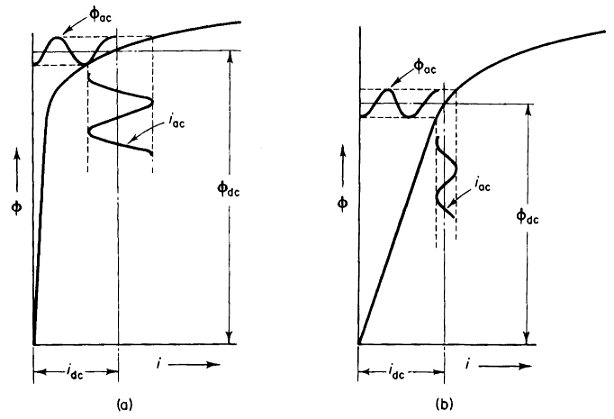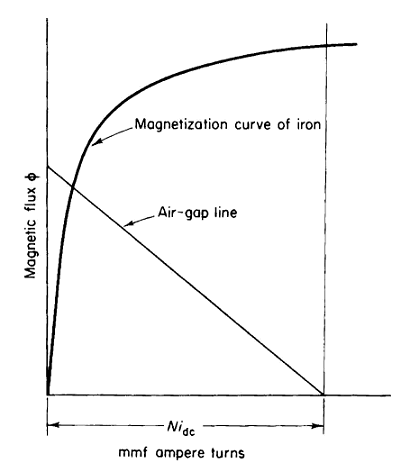| Capacitors, Magnetic Circuits, and Transformers is a free introductory textbook on the physics of capacitors, coils, and transformers. See the editorial for more information.... |

|

Home  Excitation Characteristics of Iron-Core Reactors Excitation Characteristics of Iron-Core Reactors  Effect of Air Gaps Effect of Air Gaps  Air Gap to Prevent D-C Saturation Air Gap to Prevent D-C Saturation |
|||||






|
|||||
Air Gap to Prevent D-C Saturation
There are circuits in which reactors or chokes and transformers carry components of alternating current and direct current simultaneously. This is particularly true of many circuits associated with electronic devices. A typical circuit that carries alternating current and direct current simultaneously is a single-phase, dry-type rectifier in which alternating current is converted into unidirectional current, which is generally a pulsating direct current unless provision is made for smoothing out the ripples. In such circuits iron-core reactors, known as chokes, are used to suppress the ripples so that a smooth direct current is produced. The characteristics of a choke should be such that the choke offers a relatively low amount of resistance to the direct current, while at the same time possessing high reactance. If the direct current in the winding of such a choke develops a large enough mmf to saturate the iron appreciably, the inductance will be correspondingly low. As a result, a choke of excessive size is required for obtaining the desired value of inductance for the alternating component of current. Direct-current saturation can be made negligible by the use of an air gap in series with the flux path. However, if the length of the air gap is too great, the magnetic reluctance is excessive and the inductance is correspondingly low for a given size of core and winding. The effect of an air gap on current ripple is shown in Figs. 5-14(a) and 5-14(b). For a given d-c component idc in the current and a given a-c component Φac in the flux or flux ripple, the a-c component in the current iac is smaller [as shown in Fig. 5-12(b)] when the core has an air gap than when it has none [as indicated in Fig. 5-14(b)]. The presence of the air gap therefore makes the reactor or choke more effective in suppressing the a-c component or ripple in the current by increasing the value of Ld, the differential self-inductance.
In applications where the a-c flux is small in relation to the d-c flux, the length of the air gap should be such that the air-gap line intersects the magnetization curve of the iron near the bottom of the knee, as shown in Fig. 5-15.
The calculation of the a-c inductance of chokes in which a-c excitation is superimposed on d-c excitation is outside the scope of this text. Such calculations are not analytically straightforward, but are based upon empirical data.
|
|||||
Home  Excitation Characteristics of Iron-Core Reactors Excitation Characteristics of Iron-Core Reactors  Effect of Air Gaps Effect of Air Gaps  Air Gap to Prevent D-C Saturation Air Gap to Prevent D-C Saturation |
|||||
Last Update: 2011-01-16



